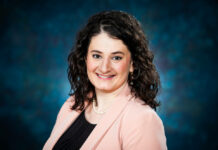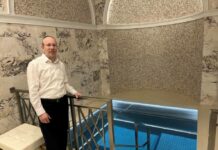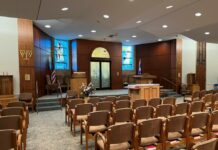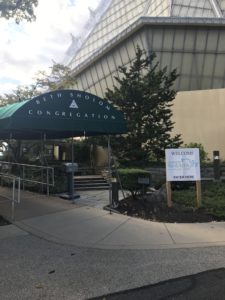
Congregation Kol Ami started in a member’s basement in 1994, evolved into a traveling community that met in local synagogues for the next 12 years and then moved into its own building, at 8201 High School Road, in 2006.
A visit to that Elkins Park site today, though, will show that a construction crew is hard at work transforming it into a yeshiva. Kol Ami sold the property in 2021 because, with the congregation shrinking from 205 households in the early 2000s to 140, it was “more than what we needed,” Kol Ami Rabbi Leah Berkowitz said.
Today, the Elkins Park synagogue is still in Elkins Park. It’s just minutes away from its old location, at 8231 Old York Road, the home of Beth Sholom Congregation.
For the last year-plus, the synagogues have shared the wide space known for its Frank Lloyd Wright-designed sanctuary on its east end. And the arrangement is going well, according to leaders from both communities.
Reform Kol Ami and Conservative Beth Sholom are still separate congregations with their own clergy, lay leaders, boards and members. But since Beth Sholom has about 450 families, down from its peak of about 850 in the 1980s, it has plenty of room for welcoming its new tenant.
There are five worship spaces and an entire classroom wing, according to Beth Sholom Rabbi David Glanzberg-Krainin. Kol Ami also has some of its own offices, Berkowitz said.
Both congregations prefer the small, multipurpose Bornstein Auditorium for Friday night services. So, Beth Sholom holds its service at 6 p.m., and Kol Ami comes in afterward at 7:30.
For a Conservative community, the Friday night service is a short, pre-dinner affair; the Saturday morning gathering is the big one. But for a Reform shul, Friday night is the main event.
“One of the reasons this arrangement works is our communities are different enough, and it would be possible to be in the same space without confusion or competition,” Berkowitz said.
“From our perspective, it’s been a wonderful relationship,” Glanzberg-Krainin added.
Berkowitz, 40, is from Delaware County but worked as a rabbi for 18 years in North Carolina, Massachusetts and New York before returning to the area in 2018. Shortly after she took the job at Kol Ami, she faced the potential move.
Synagogue leaders knew by the end of 2019 that they had to sell their property. In the early 2000s, they hoped to increase their congregation to about 225 households, but they never quite got there. And then, like so many synagogues, Kol Ami started losing members. As Glanzberg-Krainin explained, “We haven’t seen a growth of Jewish families moving to this area.”
“A lot of congregations had that goal in the early 2000s, and things shifted,” Berkowitz said of Kol Ami’s growth target. “Places weren’t growing anymore in the way that we had been.”
But months after synagogue leaders came to that realization, COVID hit, putting the sale process on hold. The pandemic also forced members to start gathering online which, in a way, brought them back to their roots.
No longer were they traveling to their High School Road campus for every synagogue activity. Instead, they were just finding a place to gather and to stay together.
“Our thought was not, ‘We don’t need a building anymore.’ We wanted to be back in person. We want to see each other’s faces,” Berkowitz said. “It just doesn’t need to be within these four walls.”
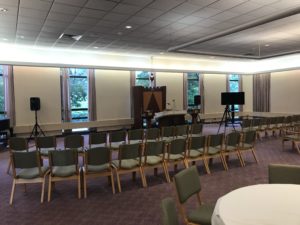
At the same time, with 140 households, Kol Ami still had too many members to just gather in people’s basements again. That was where Beth Sholom came in.
Kol Ami leaders wanted to stay in their community, according to President Gary Turetsky. Beth Sholom leaders recognized that they could help their congregation by charging rent, Glanzberg-Krainin acknowledged. But more importantly, they wanted to help preserve a Jewish community.
“The Jewish community benefits when we have more Jews who are engaged in building community,” he said.
Last summer, the groups came together.
Members enjoyed a meet-and-greet, and Beth Sholom’s president welcomed Kol Ami congregants in a speech during one of the High Holiday services. Today, the temple presidents and rabbis meet monthly, and a joint Selichot program, marking the reflective month of Elul leading up to the High Holidays, is planned for the coming days.
But leaders maintain that these are separate institutions with different prayer books, services and congregations — and no plan to merge. They are just neighbors helping each other out.
“We are very much a family,” said Turetsky of his congregation. “That is really what’s worth preserving.” JE



